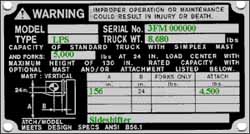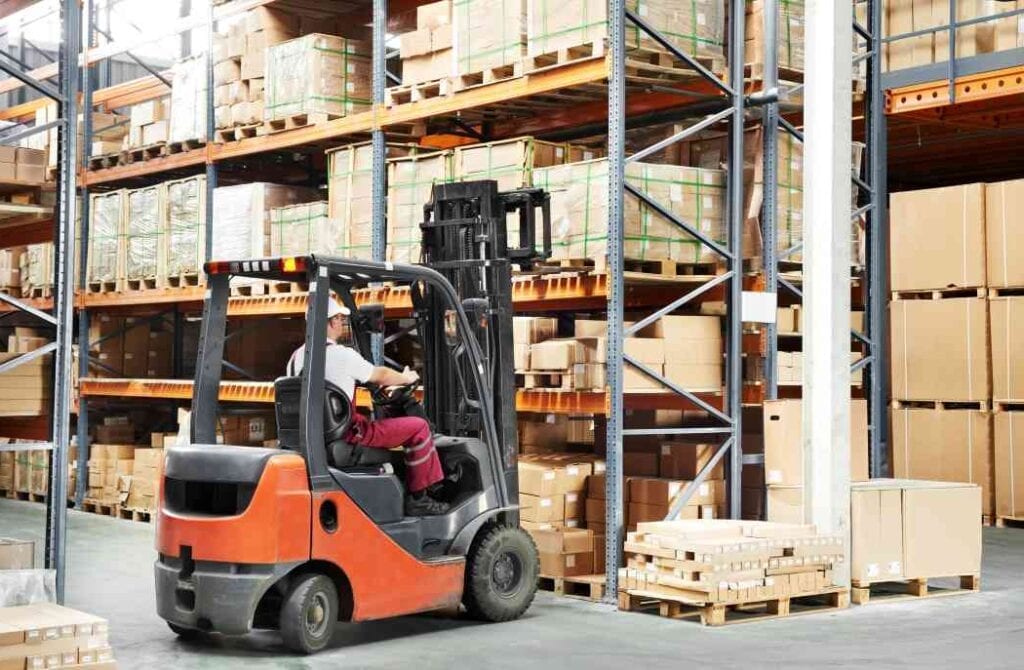It is crucial that forklift operators be trained on how to read a forklift data plate. This is the only way that they can ensure safety while operating a forklift, used or new. Luckily, all the vital information you need as a forklift operator is located in one central location on your forklift’s data plate.
This blog will run through where you can find the data plate on your forklift as well as what the information listed means. Understanding and adhering to this information is the best way to avoid injuries while using your forklift.

The data plate on your forklift can be found on the frame between either the two rear tires or over the front tire depending on whether it is a twin wheel or single-wheeled forklift. The data plate is not always visible, so you may need to remove a panel or a cover in order to access it.
The forklift data plate is an essential provision by forklift manufacturers to ensure that workers are fully aware of the specifications of their machines. The specifications may vary from one manufacturer to another, but most include the following:
Maximum lift capacity: This is the maximum amount of weight your forklift can safely lift and carry at one time.
Maximum speed when carrying a load at full throttle: This tells you how fast your forklift can travel when carrying a load.
Maximum speed without a load: This is the maximum safe operating speed of your forklift with no weight on your fork.
Minimum turning radius: The minimum amount of space needed to make turns is displayed here.
Recommended tire type and air pressure: Tells you what type of tires should be used with your forklift and the recommended air pressure for each tire to ensure safety.
Minimum fuel tank capacity: This shows how much gas is needed before refueling in order to avoid engine shutdown while transporting loads.
Engine horsepower: Your forklift engine’s power rating in horsepower.
Engine oil capacity: This tells you how much oil is needed and when it needs to be changed for safe operation.
Recommended battery type and charging specifications: Indicates the recommended battery type for electric forklifts as well as what voltage charger should be used to charge the battery.
Engine manufacturer: This is the name and address of the engine manufacturer in case you need to contact them.
Serial number: Displayed so that if your forklift gets lost, stolen, or damaged beyond repair, you can report it or file a warranty claim.
Fuel Type: Indicates the type of fuel your forklift can run on.
Other information displayed may include additional safety features such as skid plates, back tilt, tread, tire size, forklift diagram, and rollover protection bars. If there is any additional information you do not understand, be sure to ask the forklift dealer or manufacturer for clarification.
Forklifts are extremely powerful and can be operated safely with the right knowledge under your belt. However, injuries associated with forklift accidents such as burns from hot surfaces or fingers crushed by moving parts still occur daily in warehouses all over the world. To avoid these types of injury:
When you’re ready to buy your next forklift, we invite you to browse our forklift inventory before spending all day navigating the dealership floors around town. We bring the dealers to you instead, with their best quotes in hand. All you need to do is select the one that works best for you, and you can do it all without ever leaving your office.

The Used Forklift Network simplifies the buying process to get our customers the best equipment at the lowest price possible.
Links
Locations
Brands

We match you with forklift dealers near you based on what you are looking for.
Contact details
Opening hours
Address
Follow us